Have you ever stared up in the sky and considered how the solar system formed? But before we go any further, what does Solar System mean?
Many planetary systems in the universe are similar to ours, with planets circling a host star. Our system is named after our Sun, Sol, and is named after the Latin word for Sun, “Solis. ” Anything referring to the Sun is referred to as “Solar.”
In a nutshell, astronomers use the big bang theory to explain how the universe began. It is the concept that the universe began as a single point, then expanded and stretched to become the size it is now—and it is still stretching!
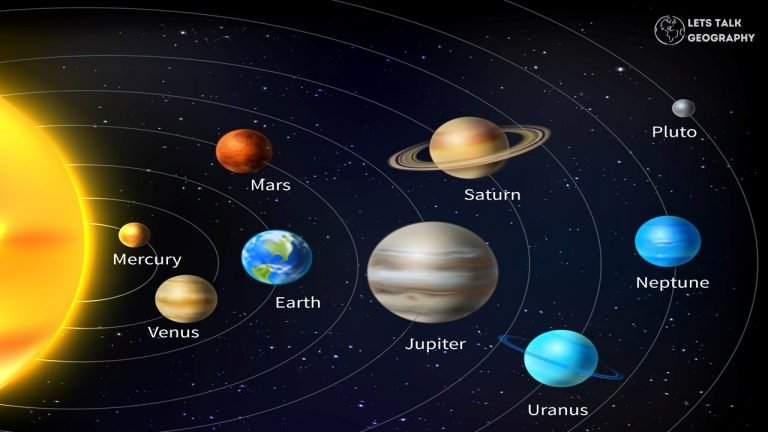
Our solar system formed at the same time as our Sun, as per the nebular hypothesis. According to the nebular hypothesis, a spinning cloud of dust composed mostly of light elements squashed into a protoplanetary disc and transformed into a solar system comprising of a star and orbiting planets.
Because the spinning nebula gathered the vast majority of material in its centre, the sun accounts for more than 99% of the mass in our solar system.
●⫸ What is Solar System?
The solar system comprises the sun and everything else in its orbit, including comets, moons, planets, asteroids, and meteoroids. It begins with the sun, known as Sol to the ancient Romans, and extends past the four inner planets through the Asteroid Belt to the four gas giants, on to the disk-shaped Kuiper Belt, and far beyond to the teardrop-shaped heliopause.
Scientists estimate that the solar system’s equator is approximately 9 billion miles (15 billion kilometers) from the sun. The giant, spherical Oort Cloud, which is thought to surround the solar system, lies beyond the heliopause.
Our solar system is just another planetary system with planets orbiting it. Although our planetary system is the only one formally referred to as a “solar system,” astronomers found over 3,200 other stars in our galaxy with planets orbiting them. That’s how many we’ve discovered so far. There are almost certainly many more planetary systems out there waiting to be discovered!
Our Sun is similar to the other 200 billion stars in our galaxy. This provides scientists with a plethora of options for searching for exoplanets, or planets outside our solar system.
●⫸ Our Solar System in Space
Our solar system is located in the Milky Way galaxy’s outer spiral arm.
A huge cloud of dust and gas known as the solar nebula collided with itself about 4.6 billion years ago. That is how the solar system formed with its sun and planets. The sun is at the heart of our solar system, a massive star whose gravitational pull keeps a slew of planets, dwarf planets (such as Pluto), comets, and meteoroids orbiting it.
Our sun is orbited by eight declared planets and at least five dwarf planets. The planets in our solar system are arranged in the way they are because of the way that’s how the solar system formed, according to a new study by the US National Aeronautics and Space Agency (NASA).
The Sun, as well as the planets Mercury, Venus, Earth, Mars, Jupiter, Saturn, Uranus, and Neptune, comprise our solar system. It consists of the planets’ satellites, countless comets, asteroids, meteoroids, and the interplanetary medium.
The Sun is the solar system’s ultimate source of electromagnetic energy (often in the form of heat and light). Proxima Centauri, a red dwarf star 4.3 light-years away, is the Sun’s nearest known stellar neighbor. On a clear night, the entire solar system, as well as the local stars, are visible.
●⫸ Composition of the Solar System
The Sun, which contains more than 99% of the system’s mass, is located at the epicenter of the solar system and influences the movement of all the other bodies through its centrifugal pull.
Mercury, Venus, Earth, Mars, Jupiter, Saturn, Uranus, and Neptune are the planets, in order of their distance from the Sun. Four planets, from Jupiter to Neptune, have ring systems, and all, except Mercury and Venus, have one or more moons.
As mentioned earlier, the Sun, according to scientific calculations, contains 99.85% of all matter in the Solar System. The planets, which formed from the same disc of material that formed the Sun, account for only 0.135% of the solar system’s mass.
Jupiter has more matter than all of the other planets combined. The remaining 0.015% is made up of planets’ satellites, comets, asteroids, meteoroids, and the interplanetary medium.
The following is a rough estimate of our Solar System’s mass distribution.
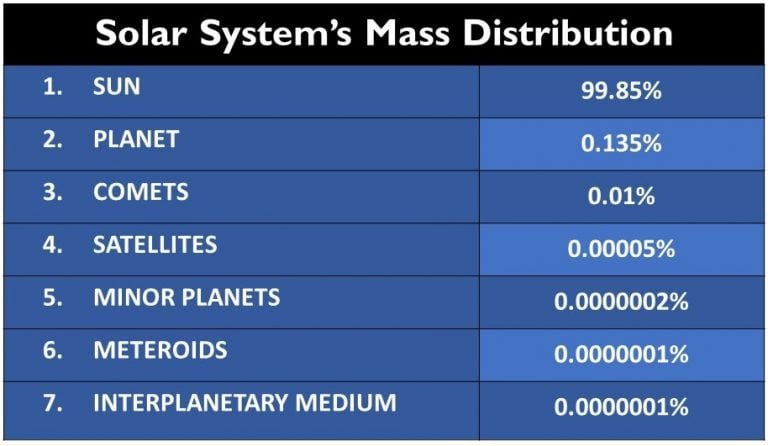
But What is this Interplanetary Space/Medium?
By volume, nearly the entire solar system appears to be an empty void. This vacuum of “space” is not nothingness; it is the interplanetary medium. It contains different types of energy as well as at least two material components: interplanetary dust and interplanetary gas.
●⫸ Planets & Their Moons
◉ The four inner, or terrestrial, planets are – Mercury, Venus, Earth, and Mars
◉ The four outer planets — Jupiter, Saturn, Uranus, and Neptune — are known as the Jovian, or giant, planets.
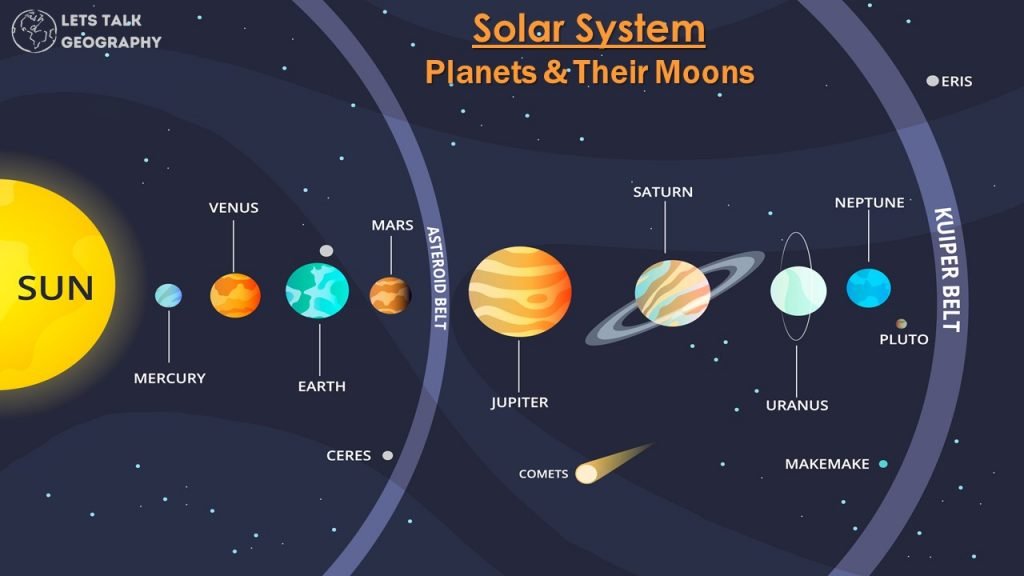
◉ Pluto is a unique icy, low-density body smaller than Earth’s Moon. It resembles comets or the large icy moons of the outer planets more than any of the planets themselves.
◉ The smaller inner planets have solid surfaces, no ring systems, and few or no moons.
◉ The four massive outer planets are much larger than the terrestrial planets. They do not have solid surfaces but a magnetic field, a ring system, and numerous known moons, which are more likely to be identified.
◉ Pluto is known to have no rings and only five moons.
◉ Several other Kuiper belt objects and asteroids have moons as well.
◉ The majority of known moons orbit their planets in the very same direction that the planets orbit the Sun. They are extremely varied and represent a wide range of environments.
◉ Jupiter is orbited by Io, a body gripped by intense volcanism.
◉ Titan, Saturn’s largest moon — a body larger than the terrestrial planet Mercury — has a primitive atmosphere denser than Earth’s.
◉ Triton orbits Neptune in a retrograde orbit — that is, in the opposite direction of the planet’s orbit around the Sun — and has plumes of material soaring through its tenuous atmosphere from a surface with a temperature of only 37 kelvins (K; 393 °F, 236 °C).
●⫸ Comets And Asteroid
◉ Don’t be fooled by the name. The small bodies in our solar system – asteroids, comets, and meteors – are full of surprises. There are presently 1,113,527 known asteroids and 3,743 known comets in the solar system
◉ Asteroids and comets are remains of planet formation in the inner and outer solar systems, respectively.
◉ The asteroid belt is abode to rocky bodies varying in size from Ceres, the largest known asteroid, to microscopic dust particles scattered throughout the belt.
◉ Some asteroids move in paths that cross Earth’s orbit, increasing the possibility of collisions with the planet.
◉ Asteroid observations from Earth, confirmed by spacecraft flybys, show that some asteroids are mostly metal (mostly iron), others are stony, and still, others are rich in organic compounds.
◉ The asteroids visited by spacecraft are oddly shaped objects pockmarked with craters; some of them have retained very primitive material from the early days of the solar system.
◉ Comets are classified based on their orbital period, or the amount of time it takes for them to revolve around the Sun.
◉ Long-period comets have orbital periods longer than 200 years (usually much longer), while short-term comets return in less time. Each type appears to have a distinct origin.
◉ A typical long-period comet’s nucleus is irregularly shaped and a few kilometers across. It has an orbital period of millions of years and spends the majority of its life at enormous distances from the Sun.
◉ In contrast, most short-period comets, especially those with periods of 20 years or less, move in rounder, prograde orbits near the solar system’s plane.
●⫸ Age of Solar System
Meteorites, or space rock fragments that have fallen to Earth, have assisted scientists in determining the age of the solar system.
Some of these small pieces of space rock, known as meteoroids, have broken off moons or planets and can provide valuable scientific information about the chemistry and history of their homebody.
A molecular cloud, like many others, collapsed billions of years ago in some forgotten corner of the Milky Way to form new stars. One of them formed in relative isolation, accumulating material in a protoplanetary disc around it before forming our Sun, the eight planets, and the rest of our Solar System.
Scientists now estimate that the Solar System is 4.6 billion years old, give or take a few million years.
The Earth and Moon are probably 60 million years younger, reaching their final form later. Furthermore, we cannot learn this by looking at the Earth itself; the rocks left over here are much older.
However, the Sun, perhaps surprisingly, may be a little older, as its formation should predate the solid objects that comprise the rest of the Solar System.
The Sun could be tens of millions of years older than the Solar System’s oldest rocks, possibly approaching 4.6 billion years old.
●⫸ How the Solar System Formed?
Our solar system evolved from a dense cloud of interstellar gas and dust about 4.5 billion years ago. The cloud imploded, possibly due to a nearby asteroid or comet known as a supernova. When this dust cloud disintegrated, it created a solar nebula, a spinning, swirling disc of material.
Gravity drew too much material into the center. The pressure in the core eventually reached such a high level that hydrogen atoms started to merge and form helium, releasing massive amounts of energy. As a result, our Sun was born, ultimately accumulating more than 99% of total matter.
Further out in the disc, the matter was also clumping together. These clumps collided and merged, forming larger and larger objects. Some grew large enough for gravity to shape them into spheres, giving rise to planets, dwarf planets, and large moons.
Planets did not form in other cases: the asteroid belt comprises bits and pieces of the early solar system that could never quite come together to form a planet. Other smaller fragments evolved into asteroids, comets, meteoroids, and small, irregular moons.
●⫸ Gaseous Mass Hypothesis of Kant:
This Gaseous Mass Hypothesis was proposed by German philosopher Immanuel Kant in 1755. This hypothesis was based on the principles of Newton’s law of gravitation and rotatory motion.
Kant’s core concept was that the solar system began as a dispersed cloud of particles. He assumed that the particles’ mutual gravitational attractions caused them to move and collide, at which point chemical forces held them together. As some of these aggregates grew larger than others, they grew even faster, eventually forming planets.
Kant did not recognize the inherent limitations of his approach because he was not well-versed in either physics or mathematics. His model does not account for planets orbiting the Sun in the same plane and direction as observed, nor does it explain the revolution of planetary satellites.
He did not explain the source of energy that caused the random motion of particles, and his assumptions were against the law of Conservation of angular momentum.
Kant’s Gaseous Mass Hypothesis, however, is significant because it was the first scientific attempt to explain the origin of the earth. Kant’s hypothesis heavily influences Laplace’s postulation of the Nebular hypothesis.
●⫸ Nebular Hypothesis or Laplacian Hypothesis
Pierre-Simon Laplace of France took a significant step forward 40 years later. Laplace was a brilliant mathematician who excelled in the field of celestial mechanics.
In addition to a monumental treatise on the subject, he wrote a popular book on astronomy, which included an appendix in which he proposed some theories about the origin of the solar system.
1. The Sun is already formed and rotating in Laplace’s model, and its atmosphere extends beyond the distance at which the farthest planet would be created.
2. Knowing nothing about the true source of energy in stars, Laplace assumed that as the Sun radiated away from its heat, it would begin to cool.
3. According to the law of conservation of angular momentum, the Sun’s rotational velocity would increase as its size decreased.
4. This process would have continued until several concentric rings formed, each of which would have coalesced to form a planet.
5. Similarly, the moons of a planet would have been created from the rings shaped by the planets as they formed.
Laplace’s model naturally resulted in planets revolving around the Sun in the same plane and direction as the Sun rotates.
Because Laplace’s theory included Kant’s idea of planets converging from dispersed material, their two approaches are frequently combined in a single model known as the Kant-Laplace nebular hypothesis.
For about a century, this model of solar system formation was widely accepted. The discovery of asteroids with unique identifiers orbits and moons with retrograde orbits during this period contradicted the apparent regularity of motions in the solar system.
Another flaw in the nebular hypothesis was that, while the Sun contains 99.9% of the solar system’s mass, the planets (most notably the four giant outer planets) hold more than 99.9% of the overall system’s angular momentum.
For the solar system to conform to this theory, either the Sun should rotate faster or the planets should revolve around it more slowly.
●⫸ Big Bang Theory
Scientists, astronomers, and cosmologists now agree that the Universe as we know it was formed in a massive explosion that created the majority of matter and the physical laws that govern our ever-expanding cosmos.
This is referred to as The Big Bang Theory. Scholars and non-scholars alike have used the term interchangeably for nearly a century. This should be no surprise because it is the most widely accepted theory about our origins.
But what does it all mean? How was our Universe created in a massive explosion, what evidence exists for this, and what does the theory say about our Universe’s long-term prospects?
▶ STEP 1-
According to the Big Bang theory, the universe began as a single point in space that was extremely hot and dense.
Cosmologists are unsure what happened before this point. Still, researchers have been functioning to paint a clearer picture of the early universe and its formation with sophisticated space missions, ground-based telescopes, and complex calculations.
Findings of the cosmic microwave background, which contains the warm glow of light and radiation left over from the Big Bang, play an important role. This Big Bang remnant pervades the universe and can be seen with microwave detectors, allowing researchers to piece together clues about the early universe.
▶ STEP 2-
When the universe was very young, it grew significantly and doubled in size at least 90 times during this spurt of expansion, known as inflation. The universe continued to expand after inflation but at a slower rate. The universe cooled and matter formed as space expanded.
▶ STEP 3-
Within the first three minutes of the universe’s formation, light chemical elements were created. Temperatures cooled as the universe expanded, and protons and neutrons collided to form deuterium, a hydrogen isotope.
A large portion of this deuterium was combined to form helium. However, for the first 380,000 years after the Big Bang, the intense heat from the universe’s creation rendered it virtually impossible for light to shine. Atoms collided with such force that they shattered into a closely packed, opaque plasma of protons, neutrons, and electrons that dispersed light like fog.
▶ STEP 4-
Matter cooled enough 380,000 years after the Big Bang for charged particles to merge with nuclei to form an atomic nucleus. The absorption of unpaired electrons caused the universe to have become transparent during this phase, which is known as “recombination.”
The light that was released at the time is still perceptible today in the form of cosmic microwave background radiation.
However, the era of recombination was followed by long darkness before the formation of stars and other bright objects.
▶ STEP 5-
Approximately 400 million shortly after the Big Bang, the universe started to emerge from its dormancy. The age of re-ionization refers to this stage in the evolution of the universe.
This energetic phase was thought to have withstood over a half-billion years, but new observations suggest that re-ionization occurred faster than previously thought.
During this period, clusters of gas collapsed sufficiently to shape the very first stars and galaxies. The ultraviolet light emitted by these energizing events cleared out and destroyed the vast majority of the bordering neutral hydrogen gas.
For the first time, the universe became transparent to ultraviolet light as a result of the re-ionization process and the clearing of foggy hydrogen gas.
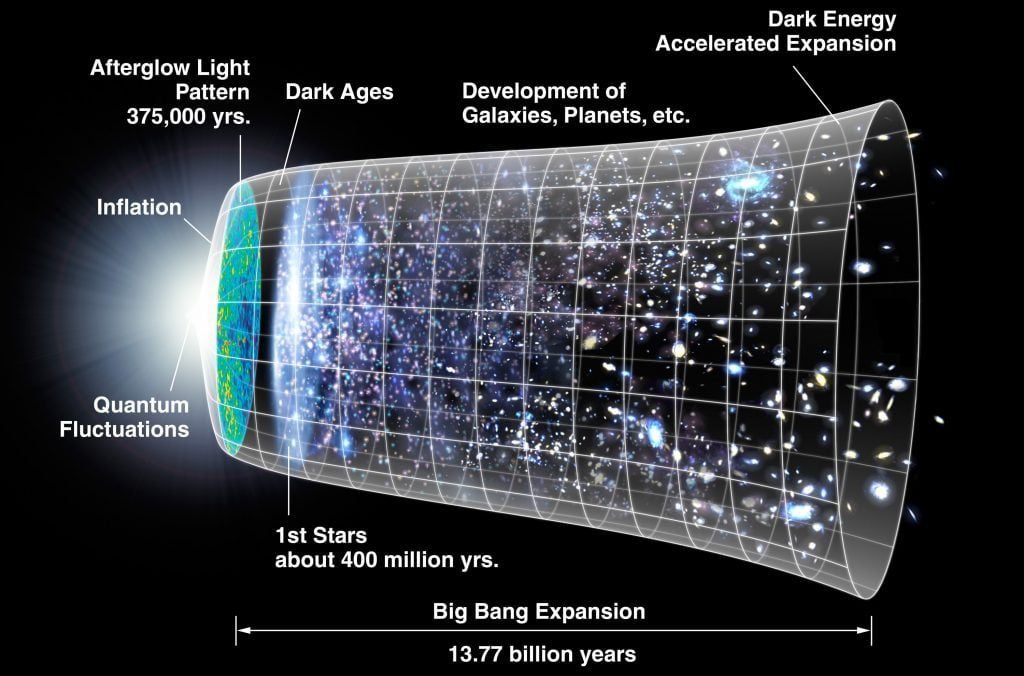
▶ STEP 6-
Astronomers scour the universe for the most distant and ancient galaxies to truly comprehend the properties of the early universe. Similarly, by analyzing the cosmic microwave background, astronomers can work back through time to piece together previous events.
▶ STEP 7-
Our solar system is thought to have formed around 9 billion years after the Big Bang, seeking to make it about 4.6 billion years old. According to the latest projections, the sun is among more than 100 billion stars in our Milky Way galaxy by itself, and it orbits the galactic core approximately 25,000 light-years away.
▶ STEP 8-
Vera Rubin, an astronomer, measured the speeds of stars in various galaxies. She discovered that all stars in a galaxy appear to circle the center at roughly the same speed.
This enigmatic and impenetrable mass was termed dark matter. According to one theory, it could be formed by exotic particles that do not interact with light or ordinary matter.
▶ STEP 9-
In 1998, the Hubble Space Telescope researched very faraway supernovas and discovered that a long time ago, the universe expanded more slowly than it does now.
Dark energy is assumed to be the strange force that is tearing the cosmos apart at ever-increasing speeds, but it goes unnoticed and is shrouded in mystery.
▶ STEP 10-
While much has been learned about the origins and theory of evolution, there are still many unanswered questions.
Dark matter and dark energy remain two of the universe’s greatest mysteries, but cosmologists persist in probing it in the hopes of learning more about how it all began.
●⫸ Other Theories
Science has proposed other theories that are thought to be reasonable in that they explain many (but not all) of the Solar System’s phenomena.
1) The Accretion theory
The Sun emerges from a dense interstellar cloud surrounded by a dusty, gaseous envelope. The challenge is getting the cloud to form the planets. Planets can form in a reasonable amount of time, but gaseous planets take far too long.
2) The Protoplanet theory
A cluster of stars is formed by a dense interstellar cloud. Dense regions form and coalesce in the cloud; because the small blobs have random spins, the resulting stars have low rotation rates.
The planets are smaller blobs captured by the star. The small blobs would rotate faster than the planets of the Solar System, but the theory accounts for this by splitting the ‘planetary blobs’ into planets and satellites.
New findings from ALMA (Atacama Large Millimeter/submillimeter Array) have shown similar disk structures in young star systems, further validating our understanding of how the solar system formed.
3) The Capture theory
The Sun converses with a nearby protostar, dragging a material filament from the protostar. The Sun’s low rotation speed is explained as a result of its formation before the planets, the terrestrial planets as collisions between protoplanets close to the Sun, and the giant planets and their satellites as condensations in the drawn-out filament.
4) Planetesimal Hypothesis
Forrest R. Moulton and Thomas C. Chamberlin proposed it around 1900. According to the theory, planets formed from the buildup of absolutely tiny bits of matter planetesimals that revolved around the sun.
The assumption that the material drawn from the stars would condense is the theory’s most serious flaw.
5) Grand Tack Hypothesis
One newer explanation for how the solar system formed is the Grand Tack Hypothesis. This theory posits that Jupiter migrated inward and then outward, influencing the formation and positions of other planets. This movement explains why Mars is smaller and why the asteroid belt has a diverse composition. This hypothesis highlights the dynamic and ever-changing environment during the formation of our solar system.
6) Solar System’s Migration and Planetary Formation
Another modern approach to how the solar system formed involves planetary migration and orbital shifts. Studies suggest planets may have shifted positions after their formation, influenced by gravitational interactions and remaining debris. The discovery of exoplanets in different stages of formation has offered valuable insights into this process.
Key Takeaway: Current scientific understanding of how the solar system formed integrates traditional models with new observations, showcasing the dynamic nature of planetary formation and migration.
◆ Conclusion:
Many theories about the origin of the Solar System have been proposed. None of them can be called completely satisfactory. However, we do believe that we have a good understanding of the overall mechanism.
The Sun and planets were formed by the contraction of a portion of a gas/dust cloud under its gravitational pull, and the cloud’s small net rotation created a disc around the central condensation.
The central condensation eventually formed the Sun, while small condensations in the disc formed the planets and their satellites. The young Sun’s energy blew away the remaining gas and dust, leaving the Solar System as we know it today.
It explains why the planets orbit in a plane and why there is a preferred orientation of gular momentum. In conclusion, our solar system was created billions of years ago by a solar nebula that became the sun.
There are many theories about how the solar system was formed. Some people have different theories about it. The Solar Nebula Hypothesis is the best explanation we currently have for the origin of the Solar System.

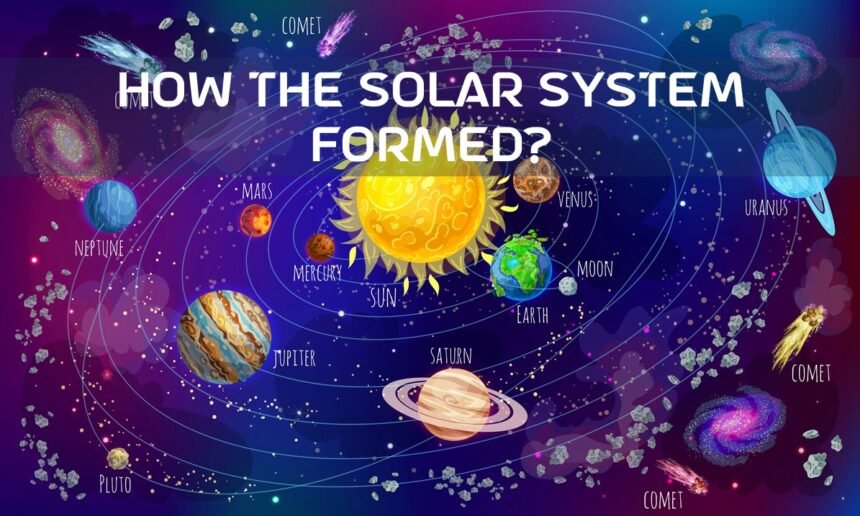
Hi there! I could have sworn I’ve visited this web site before but after looking at some of the posts I realized it’s new to me. Anyways, I’m definitely delighted I found it and I’ll be book-marking it and checking back regularly!
Hello! It’s wonderful to hear that you’ve stumbled upon our site and found it engaging. Whether it’s your first visit or a return, I’m delighted that the content has resonated with you. Thank you for bookmarking us and planning to check back regularly – that means a lot! We’re constantly updating and adding new posts, so there will always be something fresh and interesting for you to explore. If you have any topics or areas of interest you’d like us to cover, please don’t hesitate to let us know. Your input is invaluable in helping us create content that our readers love. Looking forward to having you as part of our growing community! 🌟📚👍